Contents
Sauvignon Blanc grapes are one of the oldest technical varieties used for the production of white wines. It is quite “capricious”, not very productive, demanding both on growing conditions and agricultural technology. Therefore, in the areas of amateur gardeners, the variety is rarely found. However, on an industrial scale, having thoroughly studied its advantages and disadvantages, Sauvignon Blanc grapes are cultivated all over the world.
History of breeding
Sauvignon Blanc is a grape belonging to the Western European ecological and geographical group (its homeland is the Loire River Valley in France). Its appearance is the result of a “spontaneous” crossing of Chenin Blanc and Traminer varieties used in winemaking for about a thousand years.
The exact date of the “removal” of the Sauvignon Blanc grape is unknown, but it has been mentioned in French and Swiss monastic chronicles since the end of the XNUMXth century. Now at home, it is included in the Cepages Nobles category along with very few elite varieties.
Description of the Sauvignon Blanc grape variety
The bunches of Sauvignon Blanc grapes do not look very presentable. But for the technical grade, this is not required.
bunches
The size of the brushes varies from small to medium (length within 10-13 cm, width – 6-10 cm, weight – 70-125 g). The “leg” on which the comb of the brush rests is very short.
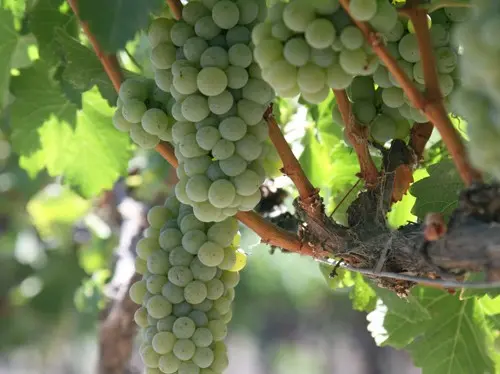
Clusters of Sauvignon Blanc grapes are cylindrical, many with a “wing”, very dense
Berries
The berries are relatively small, spherical or slightly elongated, 1,4-1,7 cm in diameter. Due to the density of the brushes, many of them are “flattened”. Each berry has 2-3 seeds.
The skin is thick, pale green in color, covered with a continuous layer of whitish “wax” coating. If Sauvignon Blanc grapes have enough light, as they ripen, they change color to straw yellow, a blurry soft pink “tan” appears on the berries.

The entire surface of the Sauvignon Blanc grape is covered with small brownish dots.
Vine
The bushes are medium-sized, not characterized by high growth rates. The new growth is greenish-white, but as it matures, it changes shade to reddish-brown.
Shoots densely leafy. The leaves are medium-sized, typical for the culture form, strongly dissected. The variety is “identified” by a narrow pinkish border along the edge of the leaf plate and a “edge” on the front side, resembling a cobweb. To the touch, the leaves are hard, as if “bumpy”. Flowers bisexual. The variety has a high percentage and reliability of self-pollination.
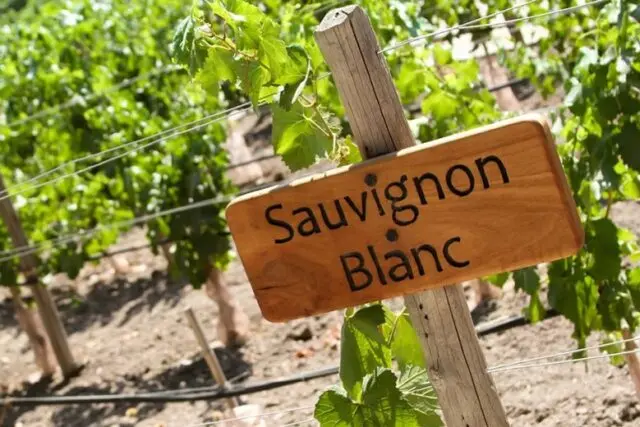
The Sauvignon Blanc vine ripens relatively well
Characteristics of the Sauvignon Blanc grape
Like any “purebred” old grape variety, Sauvignon Blanc is quite “capricious” and not without significant flaws. However, this did not prevent its wide distribution, which indicates “plasticity”.
Maturation period
Sauvignon Blanc grapes are mid-season varieties. Clusters reach technological maturity in 130-135 days, counting from the moment when leaf buds open. It is collected at the end of September or in the first decade of October. At the same time, a relatively small amount of active temperatures is needed to obtain a crop – 26-27 ° C.
Productivity
Sauvignon Blanc cannot be called a high-yielding grape. In Europe, for technical varieties, this indicator is measured in hectoliters of must per hectare, for this variety it varies between 10-45 hl/ha. Translated into figures more familiar to winegrowers, the yield is 13-60 c/ha.
Small brushes and a relatively small percentage of fruitful shoots on a bush (37-50%) are “responsible” for low rates, and each of them has only one bunch. Only recently, thanks to the scientific achievements of agronomists, combined with competent pruning, it was possible to raise the number of fruitful vines to 70-80%.

Sauvignon Blanc grape vines never suffer from “overload”
Sauvignon Blanc grape taste
The pulp is very juicy (juice content – more than 77%), has a pronounced nightshade aftertaste. Made from Sauvignon Blanc grapes in its homeland, dry white wine, which goes very well with seafood, is easily “identified” by professional sommeliers by its unique tart-sour taste and notes of red currant and gooseberries in the aroma.
Sugar content varies greatly (19-23 g per 100 ml of juice), directly depends on the local climate and the ripening time of the berries. The same applies to acidity (6,5-11 g / l).
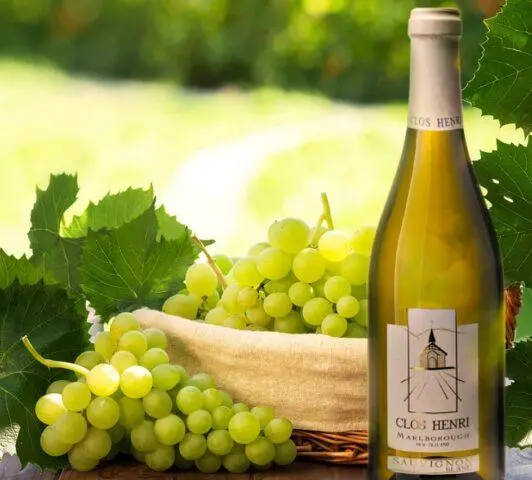
Depending on the region of growth, shades of musk, green apples may appear in the taste of wine.
Growing regions
France occupies the first place in terms of the area allocated for the cultivation of this variety. Also in Europe it is cultivated in:
- Germany;
- Austria;
- Switzerland;
- Italy
- Spain;
- Serbia
- Croatia;
- Slovenia;
- Czech Republic;
- Hungary
- Romania;
- Bulgaria;
- Of Moldova.
At the end of the XNUMXth century, the variety “moved” to the New World and adapted very well there. Wines from it, produced in Chile, Argentina, New Zealand, South Africa, successfully compete with French ones.
Sauvignon Blanc grapes are grown in the USA (California) and Australia, but the local climate is too hot for it. Berries accumulate a lot of sugar. To correct this shortcoming, the juice is used in blends with other varieties (Riesling, Aligote).
Frost resistance
Frost resistance down to -20 ° C allows the vines to winter without damage at home – the climate in the Loire Valley and in the province of Bordeaux is quite mild, seaside. However, in temperate continental conditions, the main flower buds often die from frost. In this case, “substitute” ones are activated, but most of them are “sterile”, so the yield drops noticeably.
Drought tolerance
Drought resistance is rated as medium or low. The plant prefers a relatively cool climate and does not have a sufficiently developed root system to “pull” deep groundwater.
Disease resistance
Resistance to all diseases typical of a culture is quite high, although it does not have “innate” immunity to pathogenic microflora. The only exception is the tendency to be affected by gray rot. Of the insects, the leafworm is the most dangerous for him, but her attacks are also rarely noted.
keeping quality
The keeping quality is low, the berries are perishable. They begin to rot within a week after harvest. Ripe brushes cannot be left on the vines either.
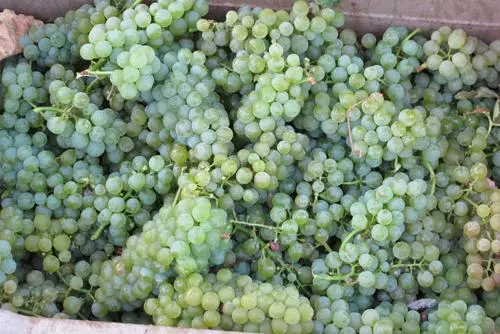
Sauvignon Blanc grapes are processed almost immediately after harvest.
Advantages and disadvantages
The aging period does not particularly affect the quality of wine from Sauvignon Blanc grapes. The drink “ripens” quickly.

Sauvignon Blanc is one of the most cultivated white grape varieties in the world.
Pros:
- the ability to adapt to the climatic conditions of different continents;
- unique taste, ideal for the production of “recognizable” white wines;
- the ability to improve the overall quality of the blend when added to the mixture;
- relatively good immunity;
- cold resistance sufficient for cultivation regions;
- good maturation of vines;
- ability to self-pollination.
Cons:
- low keeping quality and drought resistance;
- inability to be stored on a bush;
- low productivity;
- small size of brushes;
- exactingness to the conditions of cultivation and agricultural technology;
- prone to infection with gray rot.
Features of growing grapes Sauvignon Blanc
Sauvignon Blanc grapes do best in light to medium, but at the same time quite fertile soils. For its planting, humus-carbonate soil, leached chernozem, forest gray soil are suitable. Ideally, the vines should be placed closer to the top of a gentle hill, where they are guaranteed to receive enough light, and the risk of overwatering the substrate is minimized.
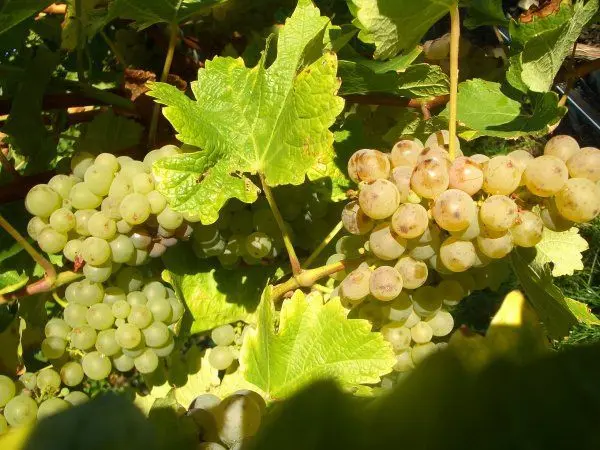
Sauvignon Blanc grapes are not thermophilic, but they cannot do without good lighting.
When grown in an optimal climate, rare watering is practiced, taking into account the age of the vine, the approximate ripening period of the berries, the quality of the substrate and other factors. If the climate is too hot for the variety, switch to frequent watering (every two weeks).
Pruning is carried out so as to provide the vine with a high load. 60-70 “eyes” are left on the entire bush, on each fruiting shoot – 8-12 (in the presence of a bole) or 6-8 buds (in its absence).
Prevention of diseases is carried out with all care. Particular attention is paid to the fight against gray rot. It is also important to prevent possible encroachments of wasps.
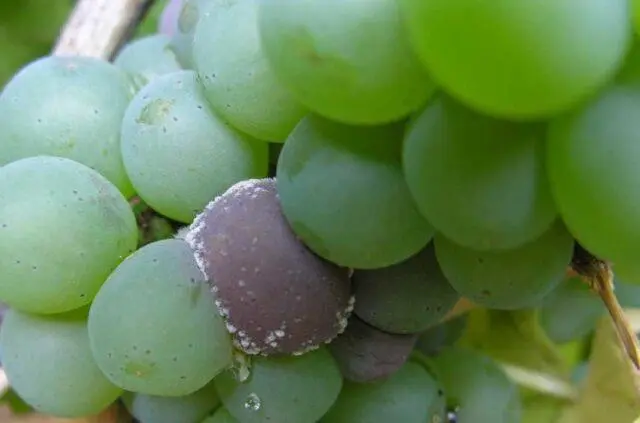
Berries affected by gray rot are unsuitable for food or for processing into wine.
If the climate in the region allows you to do without shelter for the winter, Sauvignon Blanc grape bushes are formed in the standard way. When its construction is required, the optimal configuration is a stemless multi-armed fan.
Conclusion
Grape Sauvignon Blanc is a rather whimsical variety that requires specific care. Nevertheless, its wide distribution in different countries and even continents indicates the presence of a certain “plasticity” in it. The advantages and disadvantages of this technical variety have long been well known, it is actively cultivated on an industrial scale. There is simply no alternative to the Sauvignon Blanc grape in terms of its taste and suitability for the production of white wines.









